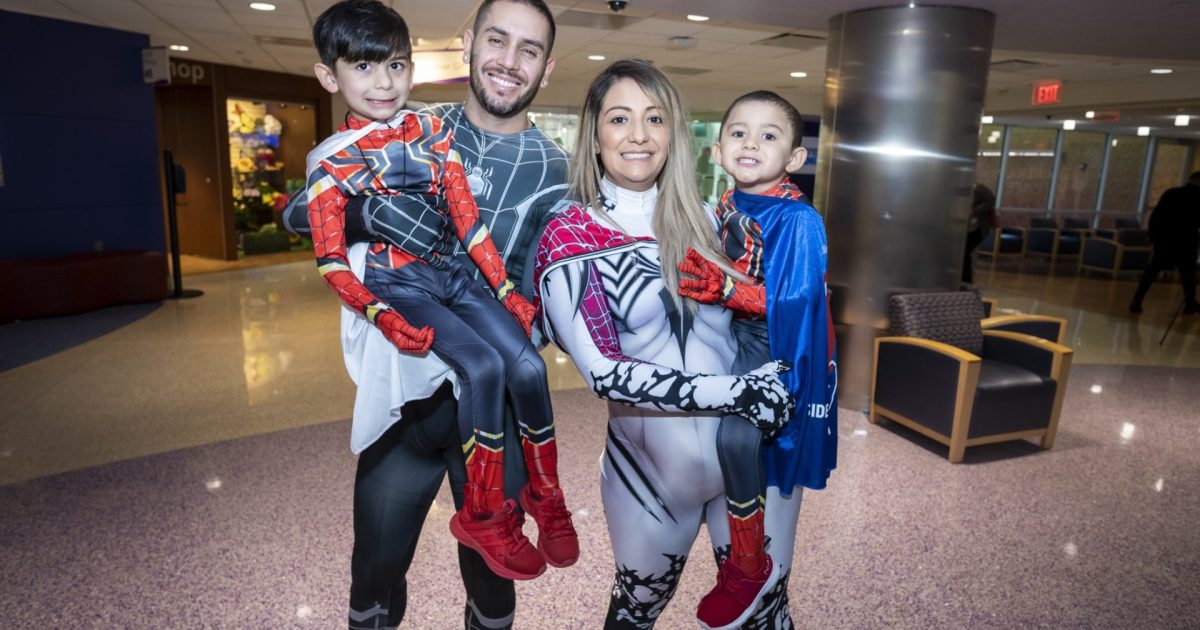Understanding The Realities Of Childhood Cancer
- Three-year-old Leone is currently battling acute lymphoblastic leukemia. He gets particularly scared when he has chemotherapy treatments, but his entire family of four has decided to dress up as superheroes to help him feel more confident when he has doctor’s appointments or receives treatment.
- Acute lymphoblastic leukemia, or ALL, is a type of leukemia where the bone marrow makes too many immature lymphocytes, a type of white blood cell. It is an aggressive cancer and requires aggressive treatment.
- Treatment advances in recent decades have lead to 85 percent of children with cancer now surviving five years or more, according to the American Cancer Society. This is up from 58 percent from the mid-1970s, but there's still a lot of work to be done.
Leone Hernandez is a 3-year-old boy who’s been fighting acute lymphoblastic leukemia since 2021. He has many doctors appointments and hospital visits, but what scares him the most is receiving his chemotherapy treatments.
Read More"We do it to make sure he feels the power."
An inspiration to them all, the family of four watches the Leone battle his cancer in awe.
"It's difficult to watch him battle," Natalia said. "But he has shown us everything is possible in life."
What Is Acute Lymphoblastic Leukemia?
Acute lymphoblastic leukemia, or ALL, is a type of leukemia where the bone marrow makes too many immature lymphocytes, a type of white blood cell. It is also called acute lymphocytic leukemia.
The American Cancer Society estimates that about 6,660 new cases of ALL will be diagnosed in the United States in 2022. The ACS also reports that the risk for developing ALL is highest in children younger than 5 years of age, with a slow decline in risk until the mid-20s. Then, the risk slowly rises again after age 50.
What Is Acute Lymphoblastic Leukemia (ALL)?
Dr. Olalekan Oluwole, a hematologist with Vanderbilt University Medical Center, previously talked with SurvivorNet about ALL's effect on the body and the type of treatments that work to fight it.
"ALL is a type of cancer that is very aggressive," Dr. Oluwole told SurvivorNet. "It grows very fast. Within a few weeks, a few months, the person will start to feel very sick. And that's why we will have to give it an equally aggressive type of treatment to break that cycle."
All About Acute Lymphoblastic Leukemia: Answers to the Most Common Questions About the Disease
Dr. Oluwole also says the leukemia often resides in the bone marrow, and because it is an abnormal growth, it just keeps dividing.
"It doesn't follow rules, and it doesn't stop," he told SurvivorNet. "Not only that, because this is part of the immune system, the immune system is sorta like the police of the body. So those abnormal cells that have now become cancer, they have the ability to go to many places. They go into the blood, and they often go into the tissue or the lining around the brain."
Understanding Childhood Cancer
Treatment advances in recent decades have lead to 85 percent of children with cancer now surviving five years or more, according to the American Cancer Society. This is up from 58 percent from the mid-1970s.
But according to the National Pediatric Cancer Foundation, more than 95 percent of childhood cancer survivors have significant health-related issues because of the current treatment options, and only 4 percent of the billions of dollars spent each year on cancer research and treatments are directed towards treating childhood cancer in the United States. Since 1980, fewer than 10 drugs have been developed for use in children with cancer while hundreds of drugs have been created exclusively for adults.
Dr. Elizabeth Raetz, director of pediatric hematology and oncology at NYU Langone's Perlmutter Cancer Center, reminded us in a previous interview that there is still reason for hope.
"There are also targeted treatments and different immunotherapies that have been studied in adults and have now moved into clinical trials for children and there has been a great deal of excitement in the community about that," Dr. Raetz told SurvivorNet.
Caring for a Child with Cancer
Still, navigating a child's cancer diagnosis can be incredibly tricky something Jayne Wexler knows all too well. She had to fill the roles of parent and cancer caregiver when her son, Justice, was also diagnosed with acute lymphoblastic leukemia. Thankfully, he has since recovered.
In a previous interview with SurvivorNet, Wexler explained how she managed to be a mother and a caregiver all at once.
"I Try To Stay Strong, But Sometimes You Need To Cry": Playing The Role of Cancer Caregiver and Mom
"Being a caregiver is a huge job," Wexler said. "Fortunately, my husband and family were very supportive … it's really hard to see your child go through this. If it could be me, I would take it in a second. You just go on auto-pilot and you just do what you have to do."
But that doesn't mean it was always easy. Wexler admitted that as a parent caring for a child with the disease, you don't have a lot of time to sit down and deal with your own emotions.
"You don't have that much time for yourself," Wexler said. "I try to stay strong, but then sometimes you just want to go and cry, and you need to cry… it's good to cry."
The survival rate for children with cancer has improved over the past few decades, but pediatric cancer is still an incredibly hard thing for a family to go through. In her own caregiving experience, Wexler found therapy to be a great way to process everything happening to her family. Regardless of whether it's therapy or participating in your favorite activities or something entirely different, it's important to find ways to also take care of yourself as you're taking care of your child.
Learn more about SurvivorNet's rigorous medical review process.

